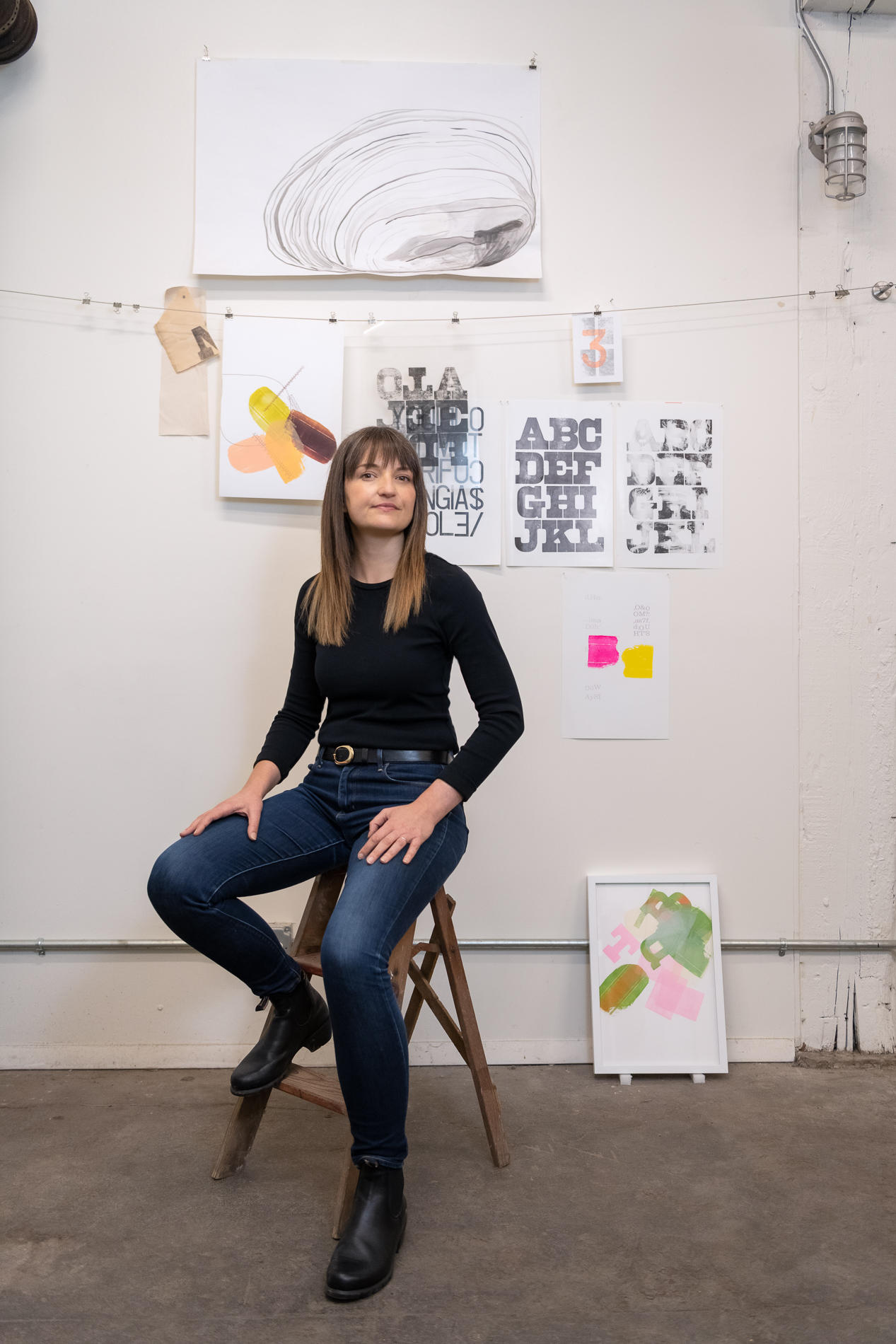Vida Sačić is a Chicago-based artist and typographer. She earned a Master of Fine Arts degree from Indiana University Bloomington in 2010. She has been the Artist-in-Residence at The Penland School of Craft and The Center for Book and Paper Arts in Chicago. Her long-term collaborations include projects at the Hamilton Wood Type & Printing Museum in Wisconsin and Tiporenesansa in Ljubljana, Slovenia. She has exhibited in dozens of solo and group exhibitions across the United States and Europe, including at DeVos Art Museum in Michigan and The Center for Book Arts in New York City. Sačić is Professor in the Art + Design department at Northeastern Illinois University in Chicago.
Artist Statement
I explore gender, identity, immigration, and labor via the printed word. My prints—made using typographic relief processes: printing plates, wood, and metal type—are largely abstract and often accompanied by assemblages of tools and sculptures.
I grew up in Croatia while it was still a part of Yugoslavia during the wars of the 1990s. From an early age, I have written original story fragments and gathered historical narratives from that region. I began printing them in various opacities and transparencies to highlight and obscure individual words, mimicking the ability of language to identify as well as to impede understanding.
Visually, my work challenges the rigid nature of the exacting equipment designed for precision printing. The organic compositions capture gestures of fluidity and motion. By resisting control over the outcome, I create pathways for exploration through processes of layering, repetition, and experimental inking within rigid structures. There is a history to the tools that I am using. They were often used to disseminate harmful narratives and prop up patriarchal, authoritarian, nationalistic, and white supremacist constructs. By creating new aesthetics and reconstructing narratives, I am actively working against that history. I create original printing plates using discarded materials and print them alongside twentieth-century matrices used to create documents. I collect plates created to print tables, maps, and official records and subvert their usage by literally turning them on the head.
Similarly, I preserve and work with the only surviving historic wood type from my hometown. This type was used to publish propaganda materials for a local factory. I also commissioned a typographic studio in Slovenia, former Yugoslavia, to produce new wood type, reimagining historical typefaces of the region in a new context.
As a part of my artistic practice, I am a writer and a sort of an archivist in that I preserve historical tools and narratives; but above all, I am a printer. Printing was the medium that defined and disseminated knowledge until the late twentieth century. As such, it offers a unique ability to question singular cultural narratives and examine how they were disseminated.
Artist Statement
I explore gender, identity, immigration, and labor via the printed word. My prints—made using typographic relief processes: printing plates, wood, and metal type—are largely abstract and often accompanied by assemblages of tools and sculptures.
I grew up in Croatia while it was still a part of Yugoslavia during the wars of the 1990s. From an early age, I have written original story fragments and gathered historical narratives from that region. I began printing them in various opacities and transparencies to highlight and obscure individual words, mimicking the ability of language to identify as well as to impede understanding.
Visually, my work challenges the rigid nature of the exacting equipment designed for precision printing. The organic compositions capture gestures of fluidity and motion. By resisting control over the outcome, I create pathways for exploration through processes of layering, repetition, and experimental inking within rigid structures. There is a history to the tools that I am using. They were often used to disseminate harmful narratives and prop up patriarchal, authoritarian, nationalistic, and white supremacist constructs. By creating new aesthetics and reconstructing narratives, I am actively working against that history. I create original printing plates using discarded materials and print them alongside twentieth-century matrices used to create documents. I collect plates created to print tables, maps, and official records and subvert their usage by literally turning them on the head.
Similarly, I preserve and work with the only surviving historic wood type from my hometown. This type was used to publish propaganda materials for a local factory. I also commissioned a typographic studio in Slovenia, former Yugoslavia, to produce new wood type, reimagining historical typefaces of the region in a new context.
As a part of my artistic practice, I am a writer and a sort of an archivist in that I preserve historical tools and narratives; but above all, I am a printer. Printing was the medium that defined and disseminated knowledge until the late twentieth century. As such, it offers a unique ability to question singular cultural narratives and examine how they were disseminated.
 Photo by
Photo by